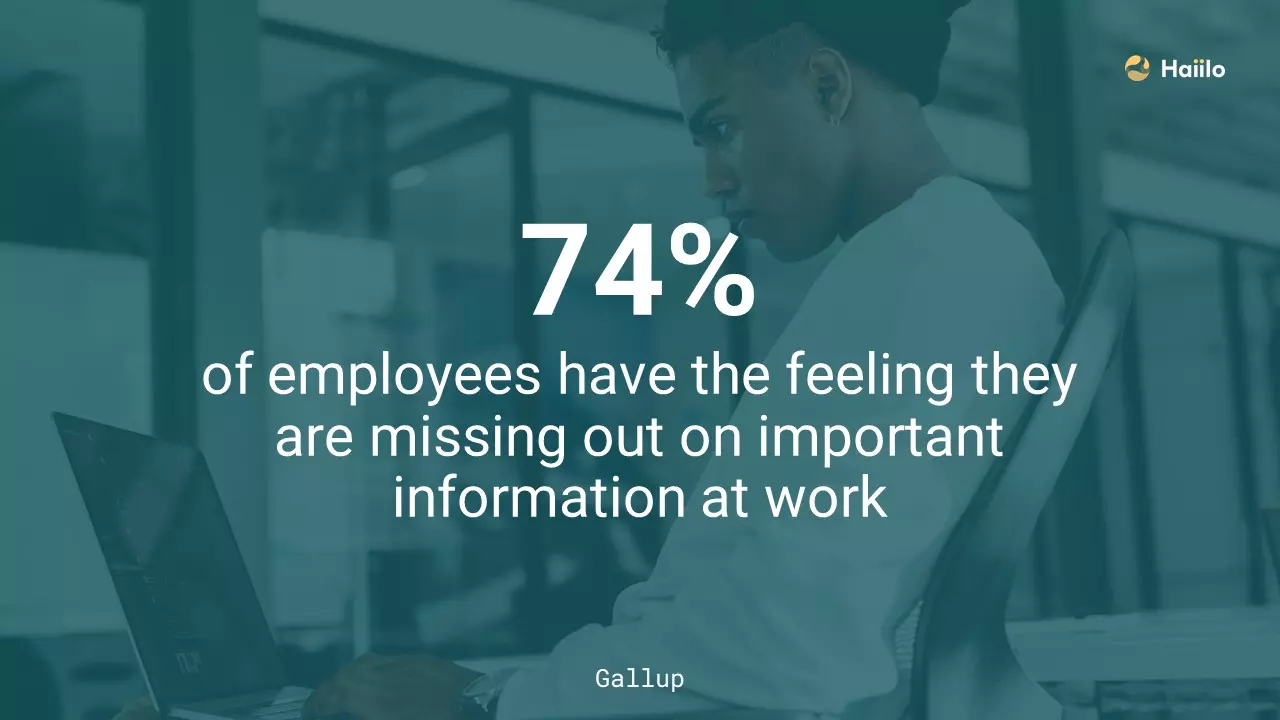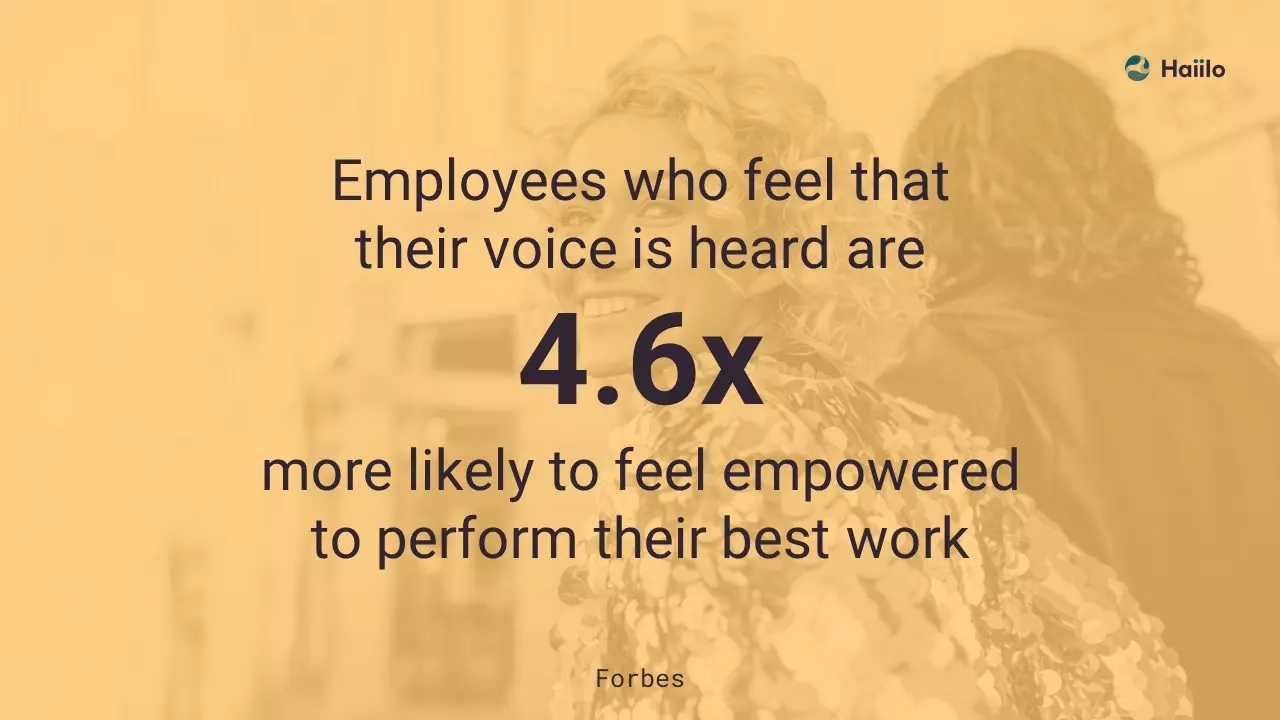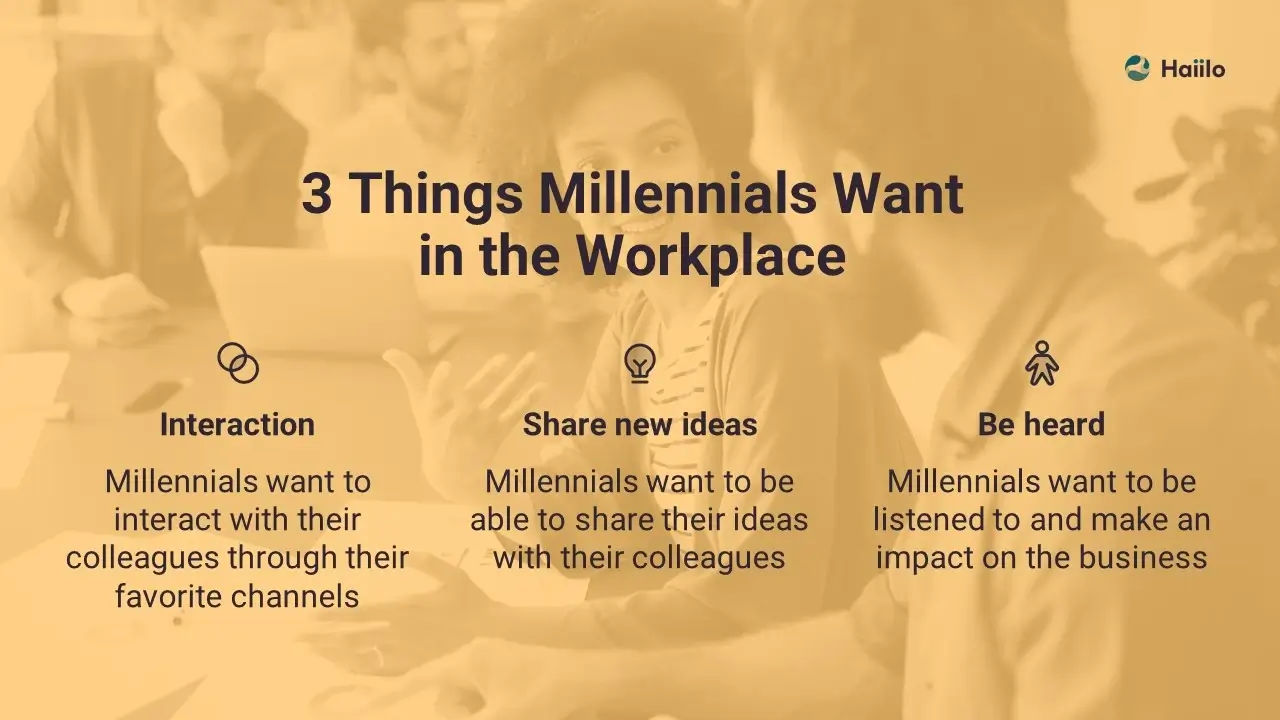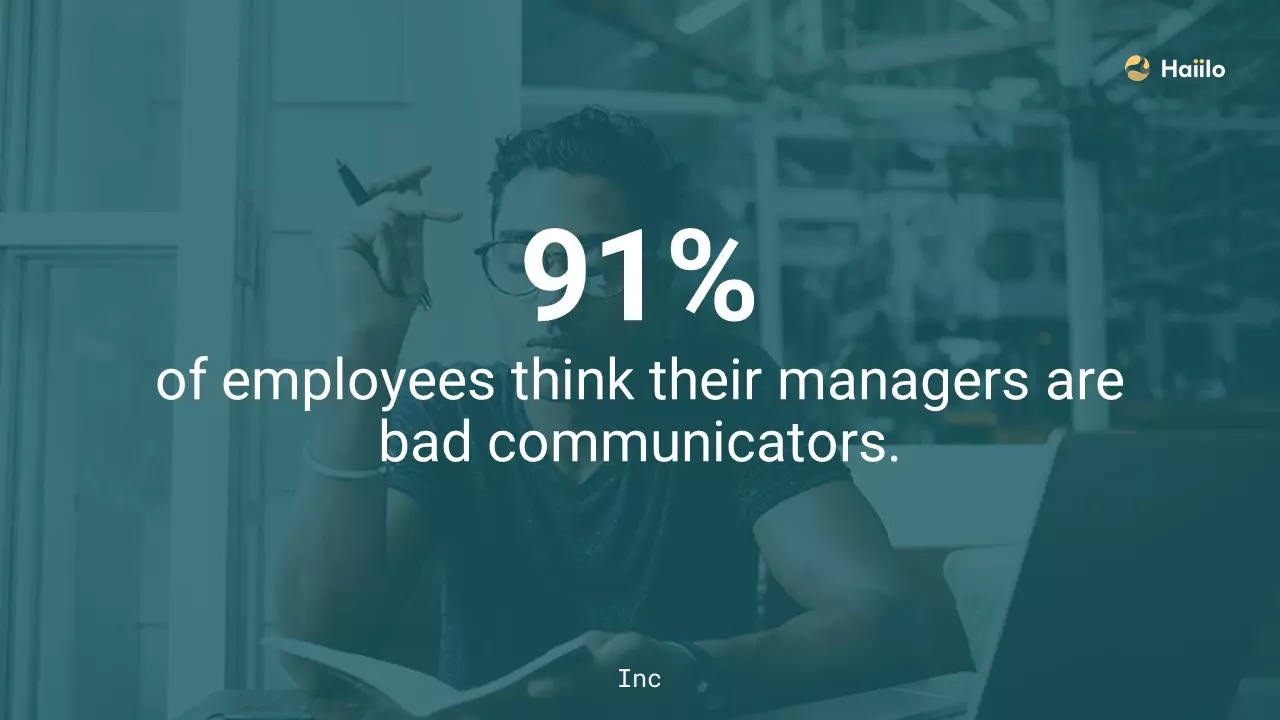Two-way communication is essential in today’s fast-changing business environment. But communicating with employees doesn’t mean sending out standardized information to the entire workforce. Building two-way relationships with your employees is the only way to build a successful internal communications strategy.
Poor internal communications are strongly connected with low employee motivation, performance, and engagement.
The way you communicate with your employees has a direct impact on the employee experience you deliver and ultimately, on your employee’s willingness to go the extra mile for your company.
Inefficient internal communications may harm your entire business. And here’s why:
- The cost of poor internal communications is quite alarming: the Holmes Report found that the cumulative cost due to productivity losses resulting from communications barriers reaches $26,041 per employee per year.
- Companies where leaders are great communicators had 47% higher total returns to shareholders over the last five years compared with firms that have leaders who are the least effective communicators.
- Worldwide, only 13% of employees are engaged in their work.
Now, the question is: how to build an internal communications strategy that inspires your employees and ensures two-way communication in the workplace?
Enable two-way communication in your company with the right IC tools
It’s all about listening to your employees. What information is relevant to them? What channels do they use the most? What are the best ways for them to share their thoughts and best practices with their colleagues?
Crafting successful internal communications starts with building two-way relationships in the workplace. It’s the only way you can drive employee engagement and empower your employees.
Employee Engagement and Workplace Communications

Before going through the key steps to building two-way relationships with your employees, let’s look at the reasons why you need to shift your internal communication toward long-term relationships.
Your Employees’ Expectations Have Changed
In today’s fast-changing world, the way we’re consuming information has changed. We now expect the information we are interested in to find us rather than having to look for it.
Additionally, employers need to move away from generic, non-personalized communications, and ensure that communication in the workplace flows two ways. However, there are many communication barriers organizations and employees are facing nowadays.
It’s All About Sharing the Right Information at The Right Time
Look at the way you’re consuming information on the web: when you’re searching for the information you need, you expect to find it right away.
When you’re opening a web page, you expect the page to open in a fraction of seconds. If the web page takes a bit longer to load, you’re most likely going to close it and look for another web page that loads faster.
We have the same type of behavior on social media. When we scroll down our social feeds, we expect to find the information we are interested in, nothing else.
Coming across irrelevant content is pretty frustrating, isn’t it?
Think about: we live in an era of information overload. We spend on average 60 hours per week consuming content on social media. What’s more, we receive on average 285 pieces of content in our news feed per day. We don’t have any time to waste reading content we are not interested in!
🎧 Also, tune in to our comms shift podcast!
Poor Internal Communication Leads to Frustration in the Workplace
The way we’re consuming information in the workplace is pretty similar. We expect the information we need to reach us rather than having to look for it.

Think about it: the average worker spends on average 2.5 hours a week looking for company or industry-related information they need to do their job. That’s more than one entire week wasted searching for information!
Related: What Is the True Cost of Poor Employee Communication?
We tend to be less tolerant of ineffective communication in the workplace. Having to search for important information is frustrating and inefficient. Overall, 74% of employees have the feeling they’re missing out on company news.
A New Generation of Employees Is Shaking up Communication in the Workplace
A specific group of your employees has high expectations in terms of internal communications. And yes, you got it right, I’m talking about millennials.
They are at the center of many types of research, and plenty of articles deal with their expectations when it comes to communication in the workplace.
But HR and IC are right to pay attention to this generation of workers: today, millennials make up about 35% of the workforce, and they are expected to make up 75% of the workforce by 2025.
They have specific expectations from their employers when it comes to communication in the workplace. And you may want to take their expectations into account when crafting your internal communication if you want to retain them!
Related: Millennials in the Workplace: 11 Ways to Attract and Keep Them
What is Two-Way Communication
Two-way communication happens when organizations enable their employees to join the company conversations, freely share their thoughts, opinions and, concerns.
Unfortunately, there are still too many organizations that don’t nurture two-way communication in the workplace. Instead, they rely on one-way, generic communications which employees don’t engage with.

As employees’ share of voice is crucial for the success of individuals and the organization as a whole, many companies are now looking for new solutions that enable them to build open, transparent and honest communication culture.
So, What Do Millennials Expect from You and Your Internal Communication?
In the workplace, millennials expect to able to communicate two-way. In other words, they don’t appreciate company-wide, generic communications. Such one-way communications tend to get ignored and neglected by various generations in the workplace.
1. Interacting with Their Colleagues Anywhere, Anytime
First of all, millennials are technology lovers. You need to build a robust internal communications strategy that helps you connect and engage with them.
Put differently, you need to shift your internals communications toward a digital communications ecosystem.
The idea is pretty simple. You need to reach your employees through their favorite channels — digital communication channels — and at the right time.
Whether it’s through their phones, a news feed similar to their social feeds, or a content booster they can use to suggest and share content, you’ll need to find the right channels to communicate with them.

If your workplace is not digital yet (you’re still sending out standardized email newsletters to your entire workforce, or you don’t use any employee communications app that allows your employees to personalize their newsfeed), you’re going to have a tough time engaging with your millennial employees!
2. Collaborating & Driving New Ideas in the Workplace
Millennials expect companies to provide them with the tools and culture that help them collaborate with their colleagues.
They are eager to develop new ideas, implement new solutions and improve internal processes.
If you don’t enhance collaboration at your workplace, millennials will get frustrated and develop their innovative ideas somewhere else!
Make sure you use a mobile-first employee communication platform so your employees can easily connect and engage with their colleagues!
3. Being Heard & Impacting the Business’s Bottom Line
Millennials want their voices to be heard. They want to be involved in your internal communications. They want to react to the messages you share with them and even create content they can share with their colleagues.
Allow them to write posts they can share with their team or the entire organization, and encourage them to create videos where they share their best practices.
Keep in mind that your employees don’t have to be experts in content creation — short videos made with phones can already take your internal communications to the next level!
Disadvantages of Top-Down Communication in the Workplace
Top-down communication is necessary: businesses of any size — from start-ups to companies with 10,000+ employees — need to communicate information to their employees.
Sending out information to keep the workforce informed about the business’s operations and goals is one of the HR and IC practitioners’ main missions.
However, in most organizations, top-down communication translates into standardized and noisy communication.
Most IC experts agree that top-down communication alone is not the best approach to drive engagement in the workplace.
For example, many businesses are still sending out email newsletters to their employees to keep them posted about the company news while they already feel overwhelmed by their overflowing inbox.
Each day, the average employee receives 121 emails and 62% of these emails are not important. As a result, your email newsletters may simply go unnoticed!
What’s more, most businesses send out email newsletters to their entire workforce on a weekly, monthly or quarterly basis without customizing it.
Even though the information communicated in the newsletter is highly important for some departments, but it may be less relevant to other departments or teams.

Standardized email newsletters don’t drive high engagement because they are not tailored to the employees’ needs.
Think about it: your employees have different roles within the organization. They work with different teams and departments. They don’t need the same information.
For example, your tech team, customer service team and legal team need information related to your business and the industry that are related to their specific mission within the organization.
You can’t help your employees find the specific information they need with standardized newsletters.
Broadly speaking, standardized top-down communication is connected with:
- Inadequate communication
- Distorted messages
- Slow employee feedback
- Employees missing out on information they need
- Poor understanding of the company’s objectives and long-term strategy
- Employees not having a clear understanding of how their jobs impact the business’s bottom line
- Lower motivation
- Lower team productivity
- Misalignment across the organization
- Lower employee engagement
To drive adoption and engagement, you need to build an internal communications strategy for and with your employees. Think about how your internal communications can empower them and help them in their daily jobs.
Related: Internal Communication: Definition, Challenges and Top Reasons Why It’s More Important than Ever
The Shift Towards Two-Way Relationships in the Workplace
Effectively communicating with employees doesn’t mean sending out standardized information to the entire workforce.
Instead, it means communicating customized information to employees and enhancing dialogues in the workplace.
This is how you start building two-way relationships with your employees.
Sharing Customized Information through the Right Channels
As explained earlier, 74% of employees have the feeling they are missing out on important company information.
What’s more, 72% don’t have a full understanding of the company’s strategy. So what went wrong? 🤔
Standardized and noisy information shared with employees is one of the reasons why internal communications are not as effective as they could be in some businesses.

Let’s get back to the example taken earlier in this post: email newsletters.
As explained earlier, sending out the same email newsletter to all employees is not the best way to keep them informed and inspired.
You can keep the idea of sending out email newsletters to your employees but instead of sending out an identical newsletter to your entire workforce, you can customize the content of your newsletter based on your employees’ role within the organization, their department and their location.
That way, you make sure that you communicate the right information to your employees. And by “the right information”, I mean the information your employees need to do their job. Nothing less, nothing more.
Of course, some information included in your newsletter will be relevant to your entire workforce. But you’ll need to tailor a part of your newsletter, so you make sure that 100% of the information you communicate is relevant to your employees.
For example, let’s say you’re responsible for internal comms in a 1,000-employee company in the banking industry. You may want to share company news such as the launch of a new service, the recent acquisition of fintech startups, or your new brand positioning to your entire workforce as this information is relevant to all your employees.
In addition to this type of information, you may want to share news related to your subsidiaries to the employees that work in these specific subsidiaries.
And within these subsidiaries, you may want to share specific information that will be relevant to each of your teams: marketing, legal, HR, tech, sales and so on.
Then, you’ll need to make sure you share information through the right channels — the channels your employees feel comfortable with and use the most.
Sending out an email newsletter may not be the way to drive adoption and engagement within the organization. Instead, you may want to share your newsletter through an employee communications platform where your employees can easily react to it.
You may even prefer to share your company news in short videos!
Enhancing Dialogues in the Workplace
Tailoring the information you share internally to your employees’ needs is the first step to build two-way relationships with your employees. The second step consists in enhancing dialogues across your organization.
You need to ask questions to your employees, a lot of questions. Have your employees read your messages? Did they understand them? How do they feel about them?
Related: Leadership Communication: How to Build Trust in the Workplace
Encouraging your employees to speak up and share their thoughts is the only way you can ensure that:
- Your employees have received and read your message
- They understand the recent changes your business is undergoing
- They know how their jobs impact the business’s bottom line
- They know where to find the information they need
- Your employees feel heard
- You have communicated to your employees in an effective way
- You build trust with your employees
Having chats or setting one-on-one sessions with your employees is a good start, but that’s not enough to build two-way relationships with them.
You also need to have a methodology in place that allows you to collect feedback from your employees.
For example, organizing a poll survey is a great way to collect qualitative and quantitative data you can compare over time.
You can even go further by shifting your internal communication toward a new model where your employees are encouraged to react to your messages, comment on the content you’ve shared with them, and create their content.
Indeed, you can’t build two-way relationships with your employees if you don’t encourage them to speak up.
Two-way relationships involve two-way communication. You share information with your employees, but you also listen to them. It’s the only way you build trust in the workplace.
You’ll need to allow your employees to share their thoughts on the content you’ve shared with them, how they feel in the company, and the business overall. Encourage them to share their best practices with their colleagues or what it’s like to be working at your company.
Ask your employees what they want to write or talk about and most importantly, let them decide how they want to express themselves!
For some employees, liking or commenting on your content already helps them feel empowered. For others, they may want to take a step forward by writing short posts or create short videos where they share their best practices with their team.
You can make it more fun by rewarding your most active employees through a gamification system.
Finding new ways of communicating with your employees is a great way to unleash your creativity!
Even though listening to your employees may sound easy, it may be the most difficult part of the process. But once you build a relationship of trust with your employees, you’ll be able to take your internal communication and the employee experience you deliver to the next level!
Related: 8 Reasons Why Internal Communication Is the Key to Organizational Alignment
Building Two-Way Relationships at All Levels of the Organization Is the Key
To run a successful internal communication, you’ll need to build two-way relationships at all levels of your organization.
HR and IC practitioners build the internal communications strategy and strengthen employee experience at the company level, but managers and team leaders play an important role in internal communications as well.
More precisely, managers are responsible for communication within their teams.

The way managers communicate with and motivate their teams has a direct impact on how employees feel about the company overall.
Ultimately, the relationship managers build with their team has a great impact on employee engagement.
Indeed, employees don’t leave the company. They leave their managers.
Only 12% of employees who have quit their job did so to negotiate a higher salary somewhere else while 75% quit their job because of the bad relationship built with their direct supervisor. What’s more, 91% think their managers are bad communicators.

So, what are the key learnings here?
If you want to drive adoption and employee engagement, you’ll need to rethink your internal communication but also help your managers build stronger relationships with their teams.
Most importantly, you’ll need to help team leaders to establish a relationship based on trust with their team.
But getting employees’ trust doesn’t come easy, your managers will have to earn it. Provide your managers with communication tools that help them connect with their employees, office-based and remote.
Related: Leadership: What Are the Qualities and Characteristics of a Great Leader?
More precisely, use an internal communications tool that will help your managers:
- Communicate the company’s goals and vision to the team
- Explain the team goals and how they fit with the company’s goals
- Explain to each employee how they contribute to the team’s success
- Explain how they impact the business’s bottom line
- Create a sense of common purpose
- Explain to each employee what the other employees’ role and mission within the team are
- Explain how employee’s missions are interconnected within the team
- Explain the impact the team has on the other teams
- Provide ongoing feedback
- Ask employees for feedback — welcome to the era of reverse feedback!
- Encourage employees to suggest ideas, either to reach targets in a more effective way or to improve internal processes.
Final Thoughts
Your internal communication has a direct impact on how your employees feel about the company and their job. Today, employees want to be heard, connected with the rest of the organization and empowered.
Communicating with employees doesn’t mean sending out standardized information to the entire workforce. Instead, it means tailoring information communicated to the employees and enhancing dialogues.
Put differently, building an effective internal communications strategy starts with building two-way relationships in the workplace.










